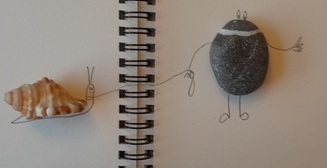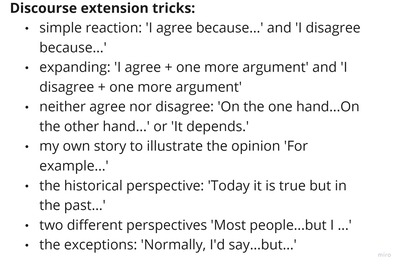
Ingredients
- A set of cards with opinions, for example those that have been used with adults or those that have been used with teenagers.
- A list of the discourse tricks displayed on the board or on the screen (see below) if the activity is done in pairs OR a set of six thinking hats if you want the students to debate in groups of 3 – 6 people. I have created two versions of these here and here. If you are interested in the orignal thinking hats that this activity was inspired by, you can start here.

Procedures
- Pairs: student A expresses an opinion which, in the earlier stages, can be limited to only reading the opinion off the list or cards) whereas student B reacts to it using one of the approaches. Afterwards, they swap roles. It is good to highlight that student B has to use a different approach in every round.
- Small groups: student A expresses an opinion (see above) and the other students in the group react in accordance with the hat that they are wearing in this round. Afterwards, they swap roles and the new hats are assigned. In the original activity, in the real classroom, we have been using dice. In the online world these have to be replaced with the wordwall spinner.
- Regardless of the format, it is better to play the first few rounds with the whole class and with the active participation of the teacher to show the students that it is in fact easy to switch from one hat to the other and that the hats really help to generate ideas.
Why we like it
- The main aim of this kind of an activity is for the students to develop the habit of reacting to what their interlocutors say and to give them a range to tools (or tricks) to contribute and to develop the contributions of other students. Hopefully, with time, my students will be able to participate in a debate and opinion exchange without any support of the spinner or the display.
- This activity also encourages the students to listen to what their peers are saying. This has been more useful with the teenagers and juniors who are more likely to space out and start daydreaming in class.
- The list of all the tricks can be limited to only the two basic ones (I agree / I disagree) and, later on, when the students are ready, further extended.
- The wordwall spinner in the online classroom was a bit time-consuming for my liking but it turned out to be very beneficial for my shy / withdrawn / panicky adult students because it gave them the additional time to think and to assume the new role. Later on, we were able to switch to a simple list which served only as a reminder of all the options out there.
- The same goes for the whole class and teacher participation. With some of my adult groups, I had to be involved more in the beginning, to model both the activity itself (to help with the speaker’s block (does it even exist) and, at the same time, to model the ways of getting involved in a debate. Otherwise, they would be just ‘politely’ waiting to be nominated to speak, even at the C1 level.
- I have been using these with my adult groups and with my young learners, too, with teens and with juniors, when appropriate.
Happy teaching!